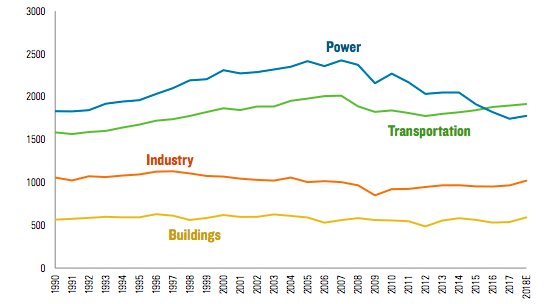U.S. Carbon Pollution Surged in 2018, After Years of Stasis
The Atlantic
SCIENCE
It’s an ominous sign for America’s ability to meet its goals under the Paris Agreement on climate change.

Steam rises from a smokestack at sunset in Lansing, Michigan, in January 2018.BRENDAN MCDERMID / REUTERS
Carbon-dioxide emissions from the United States spiked sharply in 2018, bucking a three-year trend and making it more likely that the country will fail to meet its promises under the Paris Agreement on climate change, according to a preliminary analysis published Tuesday.
The new study—written by the Rhodium Group, an energy-research firm—found that emissions of the heat-trapping gas leaped by 3.4 percent, the second-largest increase in more than two decades. The emissions surge was driven by a number of factors: Americans flew more, shipped more goods by truck, and burned more heating oil during a frigid winter.
Even emissions from power plants went up, after years of declines. A record number of U.S. coal plants closed in 2018, but a booming natural-gas sector gobbled up those declines and generated most of the year’s growth in electricity, too.
Where Are U.S. Carbon Emissions Coming From?

U.S. carbon emissions are still down from their historic peak in 2005. But they have not fallen nearly far enough. Under the Paris Agreement, the Obama administration voluntarily promised to cut U.S. emissions by at least 26 percent by 2025, as compared with 2005 levels. Though President Donald Trump pulled out of the Paris Agreement in 2017, the United States is still technically subject to the treaty until next year, and dozens of liberal states and cities have pledged to uphold its terms.
Despite those commitments, the United States has lost ground on its Paris goals. In 2017, emissions were 14 percent below their 2005 peak; now they are only 11.2 percent below peak. The country could still make its Paris targets, the report says. But meeting that goal will require either an aggressive new federal climate policy or “favorable market conditions” in the next few years. There is no seven-year period on record when U.S. carbon emissions have fallen as quickly as they must between now and 2025.
Despite those commitments, the United States has lost ground on its Paris goals. In 2017, emissions were 14 percent below their 2005 peak; now they are only 11.2 percent below peak. The country could still make its Paris targets, the report says. But meeting that goal will require either an aggressive new federal climate policy or “favorable market conditions” in the next few years. There is no seven-year period on record when U.S. carbon emissions have fallen as quickly as they must between now and 2025.
“The U.S. was already off track in meeting its Paris Agreement targets. The gap is even wider headed into 2019,” the report warns.
The Rhodium report is not the first clue that 2018 was basically a terrible year for the climate. Last month, two studies also found that worldwide carbon emissions surged in 2018. This change is a discouraging sign, since global emissions stagnated through the middle of the decade.
“From 2014 through 2016, we saw emissions that were flat while the global economy grew,” says Rob Jackson, an author of one of the studies and a professor at Stanford University. It was a “great outcome,” he said, because it suggested that the worldwide economy could grow without also boosting carbon emissions. Some analysts had even hoped that worldwide carbon emissions were about to peak.
“Now we’re back to a much faster rate of increase,” Jackson told me.
We want to hear what you think about this article. Submit a letter to the editor or write to letters@theatlantic.com.








Follow Us!